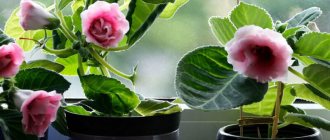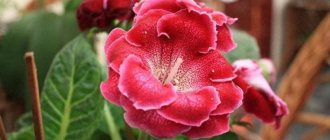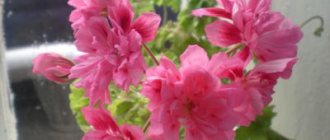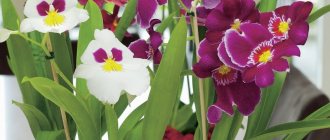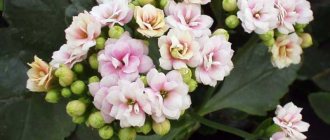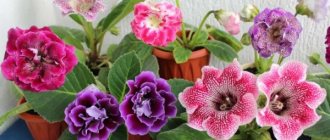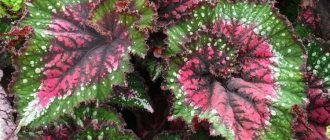Industrial grades
Culture lovers sometimes call such gloxinias stampings. Retail chains sell flowering bushes in transport containers and seeds. On the pack, in addition to the name of the series, the color of the corollas may be indicated, or there may be a “mix” mark, which means a mixture of colors.
Terry stampings may not be as elegant as the designer varieties, but on the whole they are no worse - bright and beautiful. But caring for them at home is easier.
Brocade
Japanese series, sometimes sold under the incorrect name Velvet f1. In fact, Brocade translates to “brocade.”
Brocard varieties have a small compact rosette, pointed velvety leaves, bell-shaped corollas with two rows of fused petals, and a short tube. Flowering is of bouquet type - the buds are concentrated in the center of the bush in a dense group, directed upward, and bloom together.
Today there are 6 varieties without names, differing in the color of the corolla. He can be:
- white;
- pink;
- red and purple - with white edging or plain.
Sonata
Dutch series with large double corollas and bouquet flowering. Available colors:
- pale pink;
- lilac;
- purple;
- coral;
- red;
- white.
The disadvantage of the Sonata series is that the bushes tend to stretch out, and it is not always possible to obtain an attractive rosette.
Diseases and pests
Under unfavorable growing conditions and the grower’s failure to comply with agrotechnical rules, the plant’s immunity weakens, and it begins to get sick and be attacked by pests. The most common disease is ascochytaosis. Develops against the background of abnormal infection by a pathogenic fungus with excessive humidity. Septoria and late blight are also common. Symptoms - leaf blades become stained, dry out and rot. For treatment, you need to remove all affected fragments and treat the bush with a solution of any fungicidal drug.
Lush flowering of Gloxinia Brocada in a decorative pot
Gloxinia Brokada is not a very fancy plant that even a novice gardener can grow. The main condition is to familiarize yourself with and follow the rules of agricultural technology.
Solid Gloxinia
Oddly enough, it is precisely these terry varieties that are more difficult to find than tiger, calico or bicolor. The corollas are smoothly colored, pastel and saturated colors are pure, sometimes changing slightly from the center to the periphery of the corolla. Specks are allowed inside the throat. The petals are fused into a short tube, arranged in at least 2 rows.
Red, crimson and burgundy
Unlike Saintpaulias, Gloxinia corollas have a deep red color. Shades may vary depending on external conditions.
Desdemona
The flowers are large, cherry-beet, double, with fringed petals. The throat is open, white, speckled. The leaves are dark, with a silver tint and malachite veins.
Red viburnum
A very beautiful variety from V. Ivanov. The corollas are flat, almost scarlet, which is very rare in the world of flowers. The petals are slightly wavy, rounded or rectangular, arranged in several rows, whitish at the base and on the inside. The leaves are dark green.
Cheerful Girl
Gloxinia from E. Nikolaeva. The flowers are red-crimson. The petals have a wavy edge and are arranged in several rows; sometimes a barely noticeable speck appears, a tone darker than the main one.
Estasi
The flower is a real rose with burgundy, velvety, wavy petals and a full center. Looks amazing.
White
These gloxinias are distinguished by their clean, elegant coloring. But you need to care for them carefully. Any speck left after touching hot or cold glass, or from a drop of water falling on the rim while watering, is clearly visible.
Madonna
The famous white terry variety. Forms a compact rosette with dark leaves. The corollas are distinctly bell-shaped, with an elongated tube, strongly wavy edges of the petals, and a blurred yellow spot in the throat. Peduncles are long and weak.
For an adult bush in a pot, you need to provide support. You can plant Gloxinia Madonna in a hanging basket and grow it like an ampel.
White Lady
The flowers are double, symmetrical, with a pronounced tube and a light lemon spot at the entrance to the pharynx. Medium-sized bush with dark plates.
Whipped cream
Variety of Victor Ivanov. A double, rose-like gloxinia with a tightly packed flower. The color is not pure white, but seems to be slightly touched with pink.
Winter Light
Gloxinia semi-mini with double flowers, which in the photo seem skillfully made of plastic. In the center of the not very large roses you can see the lemon pharynx.
Purple and blue
Black gloxinias have always been one of the most popular. In fact, there cannot be such a color of the corollas; this is what deep purple varieties are called.
Madagascar
The plant is medium in size, with long peduncles, and at the peak of its decorative value requires supports. The corollas are large, terry, fringed, blue-violet.
The throat is open, white, speckled. Breeder – Tatyana Vysota.
Negress
The famous gloxinia from Natalia Grishina. Velvet flowers up to 12 cm in diameter appear blue-black. The leaves are greenish-olive.
To achieve a truly dark color, cool conditions and bright lighting are recommended.
black Jack
Dutch variety with bouquet flowering. The petals are double, wavy, dark purple.
The pharynx is open, white, with a pronounced vascular network, colored to match the main color.
Twilling of Day
Terry gloxinia semi-mini. The deep purple corollas with a white throat last a very long time.
Pink
The group includes gloxinias with terry corollas from delicate pastel colors to bright, rich ones. At the entrance to the pharynx, the pink color often thickens and becomes darker than on the petals.
Dolce Vita
Popular terry gloxinia with large, light, pastel pink corollas. The flower is flat, the throat is dark in color, wide open. The rosette is compact, the leaves are slightly bent downwards.
Peach Rose
Gloxinia pink has a beautiful rich color. The front side of the corolla seems velvety, the back side is satiny. The center remains covered for a long time with half-closed petals.
Pink Pleasure
The name of the terry variety translates as “pink pleasure.” The corollas are mother-of-pearl, wavy, gracefully bent. The hue inside the flower is bright, and towards the edge it turns into a blurry pink.
Mouse Ice
Gloxinia is known as Pink Flamingo. Peduncles are weak and need support. The corollas are large, terry, pink with a lilac tint. The edges of the petals are slightly lighter than the main tone.
Lilac and purple
A diverse group of terry gloxinias. Shades can vary greatly, be rich or subtle, very dark or washed out almost to white.
Deep Lake
Beautiful lilac gloxinia, the name translates as Dark Lake, in catalogs it can be found under the name “Nadezhda”. The flowers are large, and when fully opened, dark spots are visible inside the tube. The leaves are light.
Tamerlane
Original large-flowered double gloxinia with wavy petals. Dark veins stand out clearly against the lilac background.
The pharynx is white with greenish tint and includes sparse, chaotically scattered dots.
Mav Ice
The color of this terry Dutch gloxinia is indicated by the name - “Purple Ice”. The petals are wavy, slightly bent towards the underside, unevenly colored, with streaks of pink.
Ariel
A lilac-blue terry variety with uneven coloring and wide petals. The base of the corolla and throat are white, with sparse purple speckling deep in the tube.
Terry gloxinia bicolor
Along the edge of the fused petals there is a thin or wide edge, sometimes blurred towards the center. The stripe can be contrasting or several shades darker than the main color. The throat is sometimes strewn with specks.
Fire of Innocence
Gloxinia is white, with a pronounced tube and a light yellow throat. The petals are wavy, decorated with a narrow, uneven, blue-blue edging.
When kept cool, the color of the strip becomes intense, but in the heat it fades. The leaves are light, the rosette is medium.
Strawberry Ice Cream
Full-double gloxinia. The flowers look like red roses with a white edge. The width of the border depends on external conditions; in hot summers it can become narrow. The petals are bent and come in large waves.
The buds are formed according to the bouquet type - in the center of the rosette, almost simultaneously.
Wild Plum
Terry white gloxinia from O. Artemova. The corolla is strictly double, open, with a lemon spot in the center. It is clearly noticeable that the petals are fused. Along the edge there is a wide lilac stripe, sometimes occupying most of the flower.
Ophelia
Delicate white petals are sinuous, edged along the edge with a narrow, blurry, very pale pink border. In places the edging is interrupted. Deep in the throat you can see purple specks.
How to properly care?
Pink gloxinia is a non-capricious plant and very grateful . In order for her to feel comfortable, you need to follow simple rules:
Water with warm, settled water.- In order not to over-water the plant and not get water on the leaves and flowers, it is advisable to water it in a tray.
- To provide gloxinia with the necessary air humidity, the flower pot can be placed in a special tray filled with wet expanded clay.
- During the period of active growth (April-September), the plant must be fed with complex liquid fertilizers.
- When flowering ends, gloxinia is prepared for a period of rest. To do this, cut off the above-ground part of the plant, leaving a stump 2 cm high, and put the pot in a dark, cool place.
- At the end of February, the tubers are transplanted into new soil, having cleared of the old soil, cutting off their rotten parts and disinfecting the cuts.
Under favorable conditions, gloxinia can throw out up to twenty buds at the same time.
Calico terry
Gloxinias have interesting colors - the main background is covered with clearly visible dots or small bright peas. Calico white double flowers look especially elegant in the photo.
Constellation of Love
Gloxinia selection by E. Statsenko. Rare crimson-red peas are scattered on a snow-white background. There are no specks along the edge of the petals.
Cleopatra
A common variety. The white flowers are densely dotted with purple or dark purple dots. At the entrance to the wide throat they are grouped into longitudinal stripes.
The edges of the petals are wavy and lightened. The reverse side is white. The bush is neat, the peduncles are short.
Winter cherry
One of the most beloved calico gloxinias by collectors. According to the description, the variety is similar to the previous one, but it is impossible to confuse the plants standing next to it.
Winter Cherry bush - semi-mini, with small leaves. Snow-white corollas are strewn with ruby peas.
Fancy Bell
Bright pink gloxinia with double petals, densely dotted with crimson specks.
The pharynx is white, the dots inside it become very small.
Further care
Rose Rococo (Rokoko) - description of the variety and its varieties
Gloxinia does not need very careful care. The main thing is to provide her with sufficient warmth and lighting. It is best to maintain the temperature at +25 °C. There should be no drafts or too humid air in the room. When dry, brown spots may appear on the leaves of the flower. But you cannot spray the bush - this can lead to its rotting. You need to feed the flower once every ten days throughout the summer. You can use ready-made fertilizers or make them yourself.
Terry tigers
Demanded, spectacular gloxinias combine the characteristics of the bicolor and calico groups. The list of varieties is updated annually.
Anfisa
One of the most famous terry tiger, authored by N. Tkachenko. The corolla is symmetrical, on a small thick tube, white with bright crimson specks and a border. The rosette is compact, the peduncles are short.
Arabella
A fantastically beautiful variety from E. Statsenko. White double flowers are decorated with a very wide dark red, fringed, uneven border, and dense polka dots. The rosette is large, the peduncles are long.
Joker
Compact gloxinia with large double flowers. A wide inky border runs along the edge of the petals; the white background is dotted with purple specks.
In the pharynx, the points become smaller and “line up” in longitudinal stripes.
The Snow Queen
Stunning gloxinia with double wavy petals. The corolla is decorated with an uneven wide lilac-blue border and violet or dark purple small dots.
Terry gloxinias out of categories
The color of the corollas of some varieties cannot be classified into any one group, but they deserve to take an honorable place in any collection. There are more such gloxinias every year.
Rose of Narnia
Variety from E. Nikolaeva. The white rim is decorated with a wide, uneven edging and marble veins of the same color.
Depending on growing conditions:
- the border can be soft lilac-blue or inky;
- the pattern takes up most of the rose-like flower, or unobtrusively runs along the edge of the petals.
Resort girl
This variety is somewhat reminiscent of an orchid. The corolla consists of two flowers seemingly inserted into each other, the third row represents rudimentary rudiments of petals covering the entrance to the light yellow pharynx. The color is crimson, the surface is covered with a thick vascular network of a darker shade.
Glamor
The second name of the variety is Lady Jane. The snow-white flowers open wide when they bloom and have pink or crimson markings.
They look like specks or a vascular network and cover a small part of the surface of the petals. May not be present on all corollas.
Flower propagation methods
Propagating gloxinia is not very difficult. This can be done in several effective ways.
Propagation by seeds
This method is perhaps the most labor-intensive, but gloxinia seedlings are more viable. For sowing, use seeds purchased at the store or collected yourself. It is better to purchase seeds in granules.
They need to be sown from January to February. After planting, seedlings appear within a month. They are planted in separate containers when the seedling has 2 leaves.
Leaf propagation
In the fall, take a fleshy, healthy gloxinia leaf. The stalk is buried in the soil so that it lies at an angle of 45°.
After the leaf gives roots, you need to transplant the plant into a nutrient substrate for further growth of its roots.
Propagation by tubers
A tuber is taken that has 2-3 sprouts and whose size is at least 6.5 cm. Then sections are made where one or more sprouts should be visible. These sections need to be disinfected and dried, and then treated with garden varnish.
The prepared tuber is planted in a container and buried so that the sprouts are at soil level.
Reproduction by peduncles
Flower stalks of simple gloxinia take root better. But this method of propagation can be used for absolutely all varieties.
To do this, cut the plant’s peduncle so that it does not exceed 7.5 cm. Then it can be placed in a glass with a small amount of water or planted directly in the ground.
Reproduction by stepsons (shoots)
The stepson is carefully cut off after flowering. Place it in a glass of clean warm water. The water is changed periodically.
After the roots appear, the plant can be transplanted into a container.
Propagation by leaf cuttings
It is obtained by dividing the petiole from the central vein. The planting process is the same as in the leaf propagation option. But the cuttings are planted vertically. They rarely need to be watered.
Attention! In order for the cutting to take root better, it is worth taking it from young shoots.
Reproduction of Gloxinia

